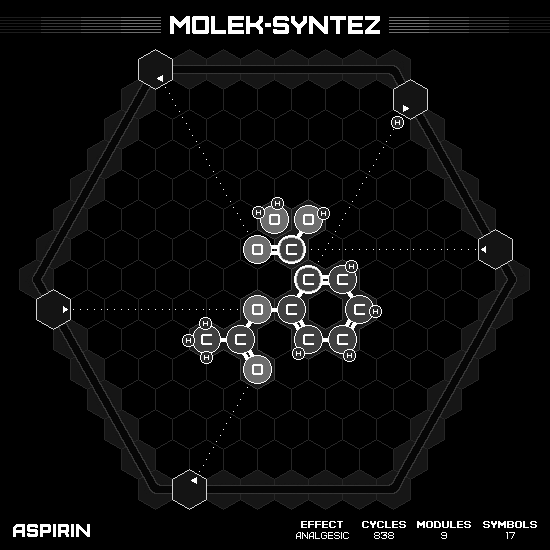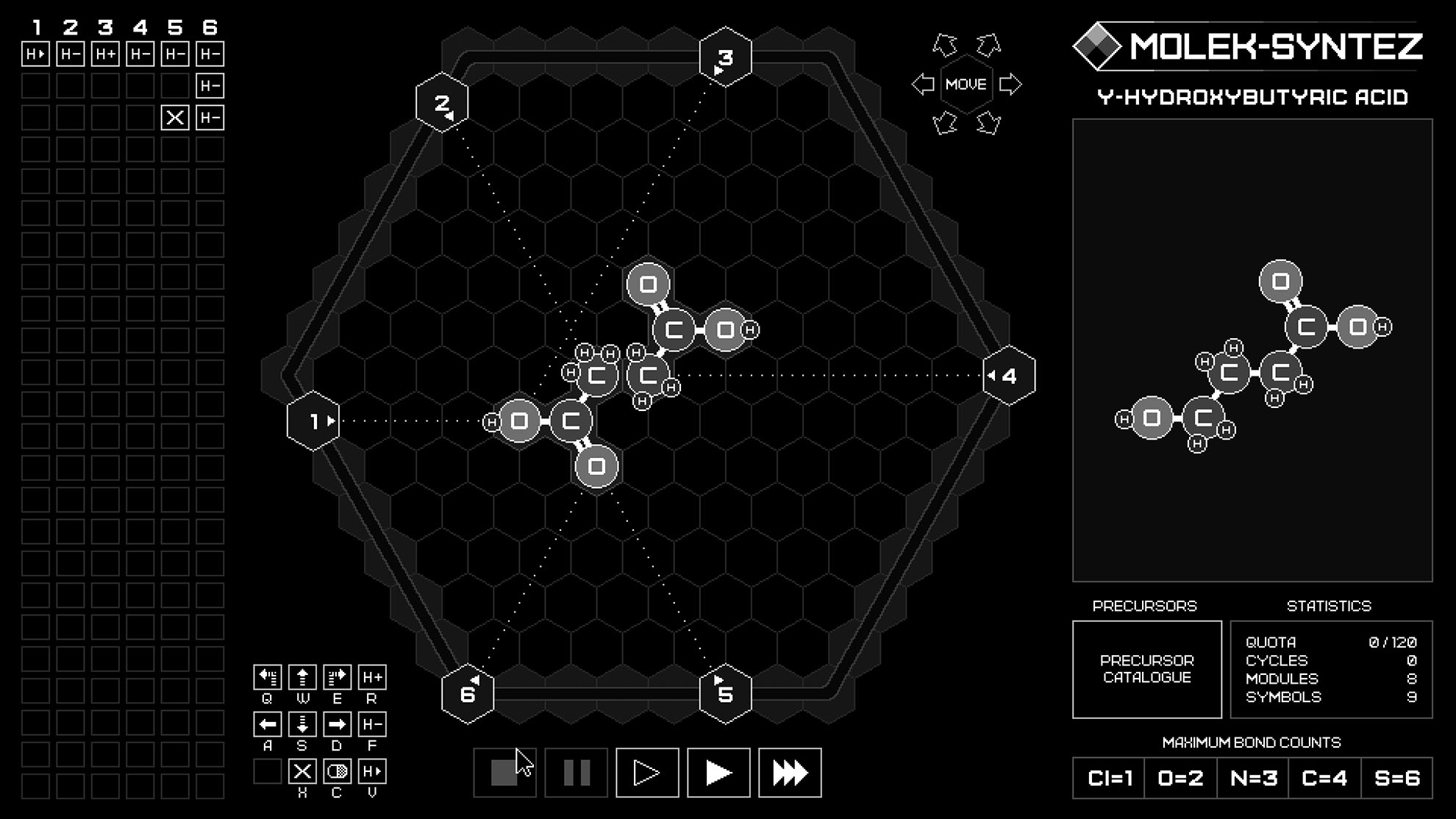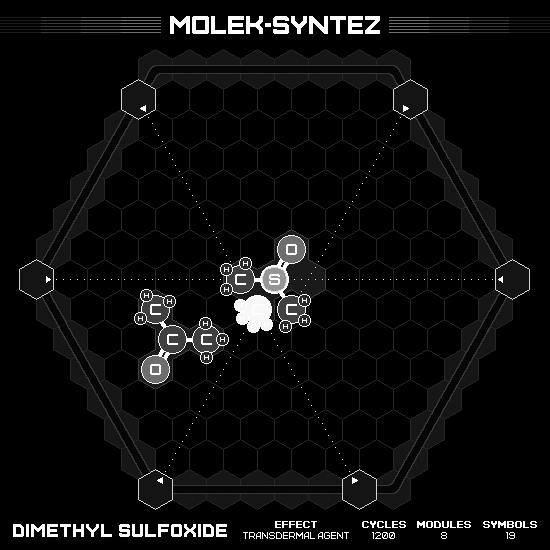Premature Evaluation: Molek-Syntez
Mountains out of molecules
A chemistry teacher once tried to teach me what a molecule is, but it didn’t stick, thanks to my chronically slippery brain which refuses to retain useful information. Please correct me in the comments below, but as far as I understand the situation, molecules are like atoms but larger and with some fun accessories. If atoms are footballs, let’s say, then molecules are those big nets filled with footballs you see hanging outside shops in seaside towns. Some molecules are good and clump together to form chemicals we like, such as water and sunshine. Other molecules are horrible and conspire to form the things we hate, like bad dreams and dangerous knock-out gases.
In any case, molecules are as important to science as they are conducive to puzzles. In Molek-Syntez, the surprise new game from Zachtronics, you are a near-future Romanian scientist in charge of a molecular synthesiser capable of poking these molecules into new shapes to form a suite of largely illegal pharmacological compounds. If you’ve ever played a Zachtonics game before, this will all be incredibly familiar to you. Molek-Syntez takes the pseudo-chemistry of SpaceChem and applies it to the fiddly micro-mechanical engineering of Opus Magnum, and wraps the whole thing in the retro user interface aesthetic of TIS-100. It plays like the greatest hits album of Zachtronics, and holds absolutely no surprises for fans of this self-spawned genre.
Each level presents you with a blank hexagonal grid and a set of six programmable emitters, which ride along on the outer rim of the grid and can fire their instructions into it. Your goal is to output a desired compound by manipulating a handful of basic precursor molecules, adding and removing hydrogen atoms to break or create bonds, and pushing, pulling and rotating parts of the molecule into new positions. Then, once you’ve designed a sequence of instructions that reliably turns a benzene ring and a slip of nitrogen into pure diazepam, you must make sure your machine can repeat those instructions on a loop, forever, without everything falling to pieces and uncontained chemistry spilling out everywhere.
Pressing the play button and watching your assembly line lurch into action is unspeakably satisfying, like a tiny factory coming to life before your eyes. Other kinds of puzzles just don’t come close to matching this feeling. A sudoku grid is satisfying in the process of filling it in, sure, but produces an ugly and uniform thing in the end. A completed sudoku is the repulsive expression of time gladly wasted, like a turd in a toilet. You would never call your partner into the room to proudly show them your finished sudoku grid. But in Molek-Syntez, just as in SpaceChem and in Opus Magnum, your puzzle solutions are special and unique, they are your molecule-spewing babies. This is why there’s a prominent ‘export to GIF’ button after each successfully completed challenge, to share your personal brand of genius with the rest of the world.
This part of the game – designing a simple machine that takes a few building blocks and transmutes them into something else – is straightforward enough, because there are no constraints on how inelegant your solution can be. Designing a crude proof of concept is always the first step to understanding how to design a more efficient drug-making machine, and optimisation is Molek-Syntez’s true challenge. You can start out by tasking a single emitter with way too many instructions, commanding it to scoot around the edge of the grid breathlessly adding atoms and creating bonds with no regard for efficiency. And then you can ruthlessly optimise, testing new ways to share the instructional load over the rest of the emitters, to see how much can be done in a single step, or by using the fewest instructions. Or you could simply try to make your machine prettier, maybe add some radial symmetry to your molecular ballet.
Trimming just the slimmest sliver of inefficiency from your design has a huge compound effect over the course of the hundreds of loops required to output everything you need to pass the level. Your results are based on three different metrics (cycles, modules and symbols) and then compared to friends and other players on a series of histogram charts, giving you a choice of three benchmarks to compete against when optimising.
Cycles are a measure of how long it’s taking your machine to output your stuff, while modules and symbols broadly track your design’s complexity and wastage. The simpler and faster a machine is, the better its overall score. To truly feel inadequate, and for a useful reminder that no matter how hard you try there will always be somebody cleverer and sexier than you, there’s the option to compare your solution to the top one percent of efficient designs. Great news for fans of crippling self-doubt.
Molek-Syntez will be in early access for a mere month before launching in December, and it’s complete enough to recommend you go ahead and buy it. But far from feeling like a successor to the richly detailed and characterful artwork of Opus Magnum, or the beautifully soundtracked SpaceChem, Molek-Syntez has the vibe of a stripped-down, lo-fi side-project, one that’s less afraid to prioritise an aesthetic over functionality. Those low-resolution and uniformly grayscale graphics are a bold choice in such a visually led puzzle game, and the impact on the grid’s legibility doesn’t seem entirely worth it. There’s also not a whole lot of content here for those who are less interested in optimising their existing designs and more interested in powering through – you could bungle through the few dozen challenges here with clunky, dumb solutions in a matter of hours.
Molek-Syntez is an unadventurous puzzler, faithfully conforming to the genre it popularised. But take the time to carefully refine your solutions, and it's as gratifying and chemically rewarding as anything else Zachtronics has made.












